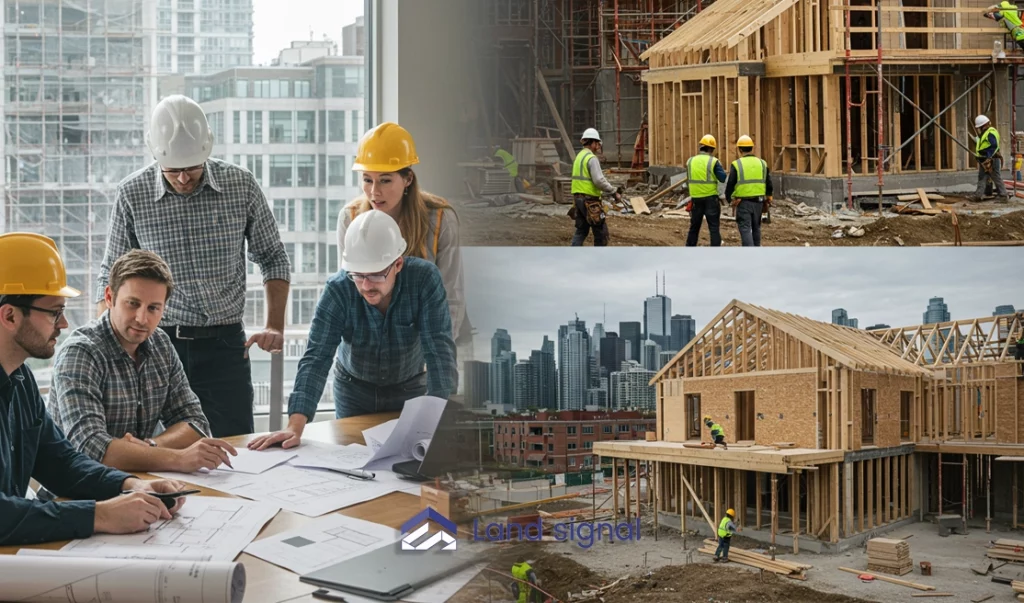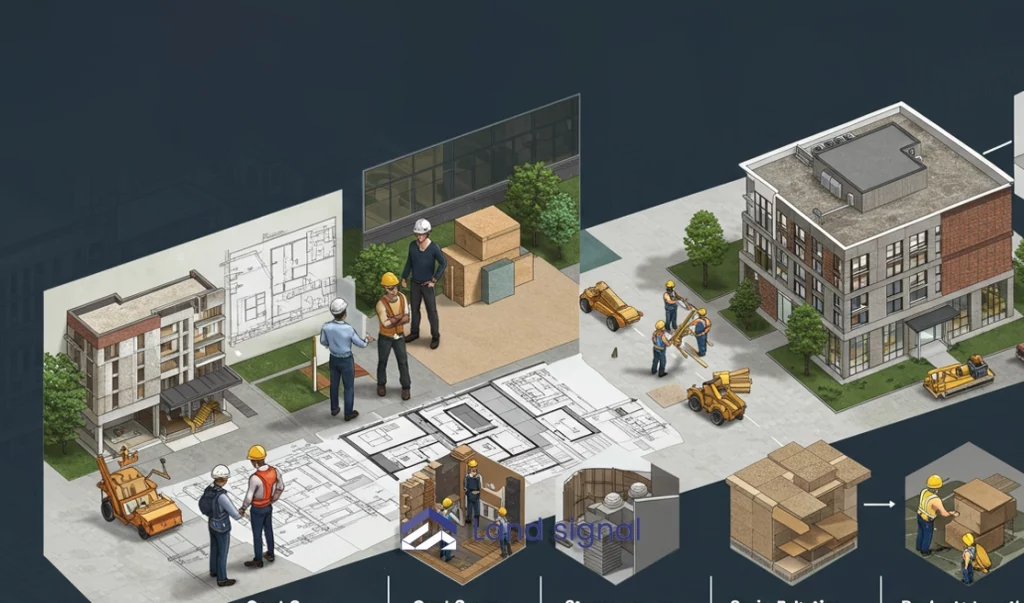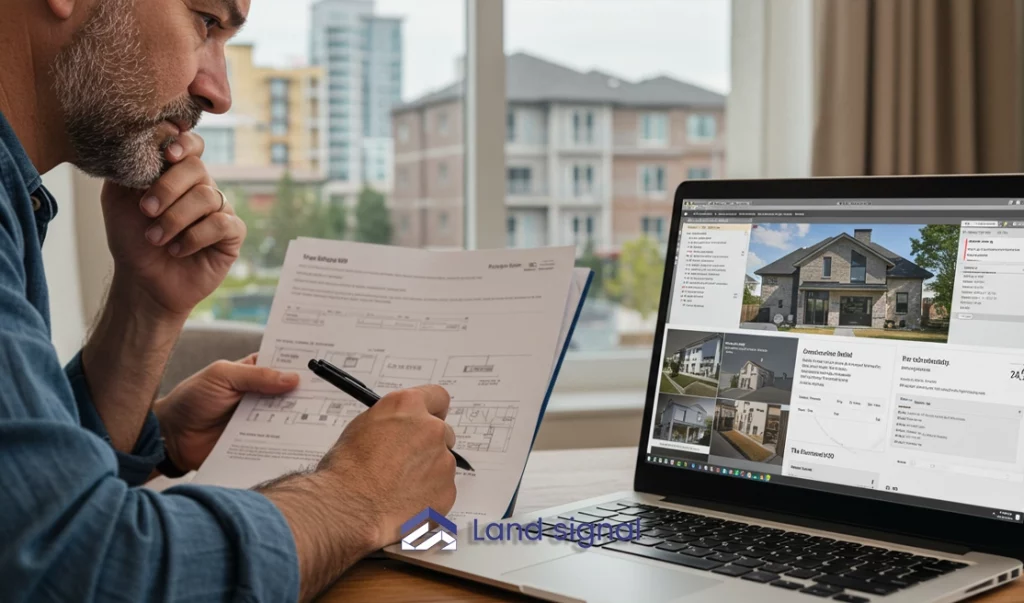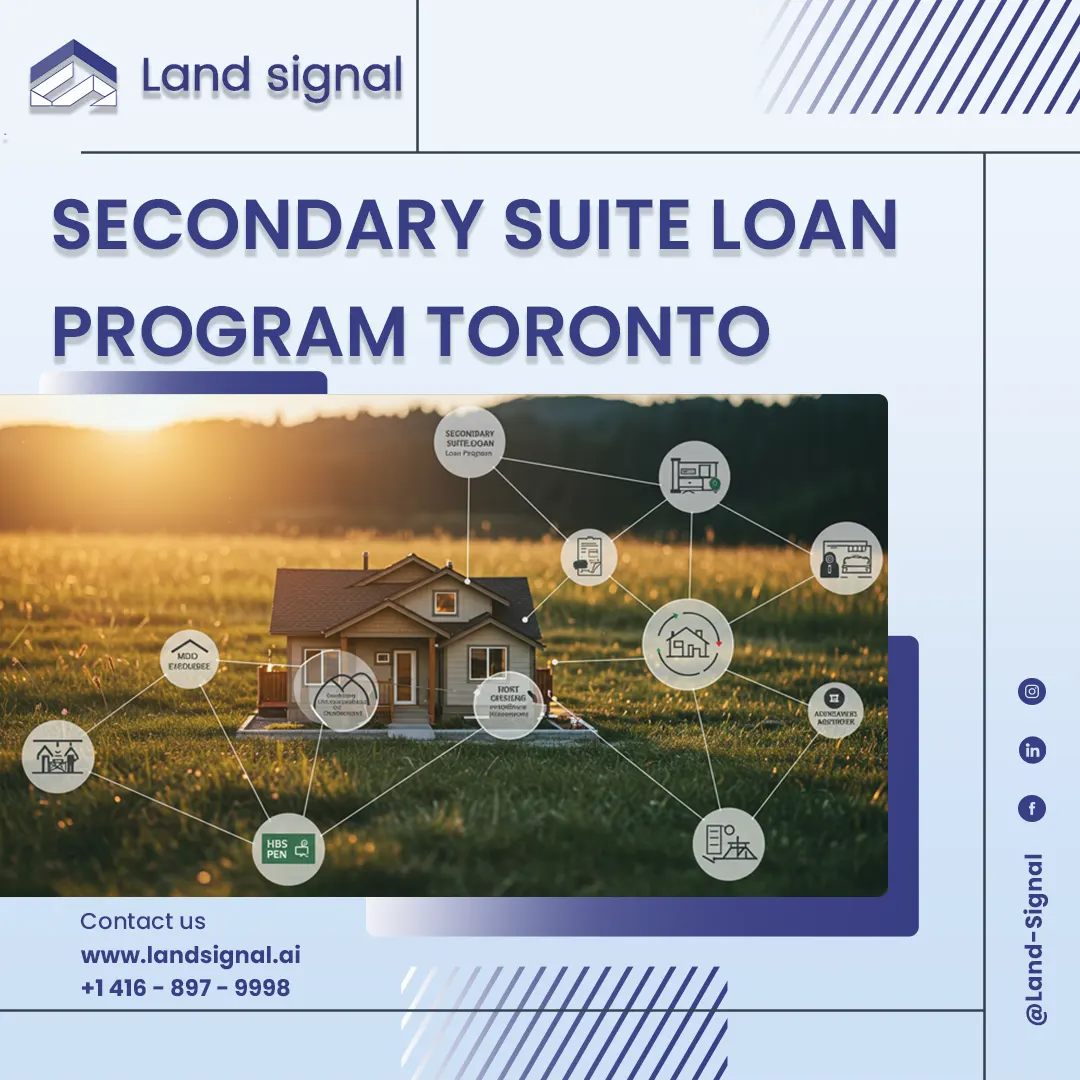The construction landscape in Toronto, a vibrant metropolis characterized by continuous growth and development, presents unique challenges and opportunities for project owners. Navigating the complexities of design, construction, permits, and regulations can be daunting, often leading to cost overruns, delays, and disputes. In this context, the design-build project delivery method has emerged as a compelling alternative to traditional construction models, offering a streamlined and integrated approach that fosters collaboration, efficiency, and cost-effectiveness.
This is where Land Signal can help. We make zoning and land use regulations easy to understand. This helps you make confident decisions about your property and projects. If you’re planning a renovation, building a legal basement suite, developing a multiplex, or starting a new home construction, we can help you get the necessary permits. We specialize in obtaining renovation permits, legal basement permits, multiplex permits, and home building permits Toronto..
This article provides a comprehensive examination of the design-build methodology, its relevance in the Toronto construction market, and the key benefits it offers to project owners. We will delve into the advantages of design-build, address common misconceptions, and provide guidance on hiring a design-build contractor in Toronto for your project.
Start Your Project with Confidence
At Land Signal, we assist with construction and renovation permits, as well as Garden House and Laneway Suite designs. Let our experts guide you through every step.
What is Design-Build and Why is it Relevant in Toronto?
Design-build is a project delivery method in which a single entity, the design-build contractor, is responsible for both the design and construction phases of a project. This integrated approach stands in contrast to the traditional design-bid-build model, where design and construction are handled by separate entities. In the traditional model, the owner contracts with an architect or engineer for design and then solicits bids from multiple contractors for construction. This separation of responsibilities can often lead to communication breakdowns, cost escalations, and delays.
The design-build model offers several advantages that are particularly relevant in the dynamic Toronto construction market. The city’s complex regulatory environment, coupled with the increasing demand for sustainable and innovative building practices, necessitates a streamlined and collaborative approach to project delivery.
Design-build provides this by fostering a single point of contact, promoting early collaboration between designers and builders, and facilitating a more efficient and integrated project lifecycle. This integrated approach is particularly well-suited to complex projects, fast-track schedules, and projects requiring specialized expertise.
Comparing Design-Build to Traditional Construction Methods
The primary difference between design-build and traditional construction lies in the contractual relationships and project management structure. In the traditional design-bid-build model, the owner manages two separate contracts: one with the designer and one with the contractor. This can create a fragmented project environment, where communication challenges and disputes can arise between the designer and contractor, often requiring the owner to act as mediator.
Furthermore, changes during the construction phase can lead to costly change orders and delays, as the designer and contractor negotiate responsibility and cost implications.
Design-build streamlines the process by placing both design and construction responsibilities under a single contract. This single point of contact simplifies communication, fosters collaboration, and promotes a more integrated approach to problem-solving. Changes during the construction phase are managed more efficiently, as the design-build contractor assumes responsibility for both design and construction modifications. This integrated approach can lead to faster project completion, reduced costs, and improved quality control.
Key Benefits of Hiring a Design-Build Contractor in Toronto
Cost Control and Budget Management
Design-build facilitates early cost estimation and value engineering, allowing for better budget control throughout the project lifecycle. The integrated approach allows for cost-saving design modifications to be implemented early in the process, minimizing costly change orders during construction. This proactive approach to cost management is particularly beneficial in the competitive Toronto construction market, where cost control is paramount.
By aligning design and construction from the outset, the design-build process reduces the likelihood of unforeseen expenses and allows for accurate budgeting from the project’s inception. This transparency and predictability in cost management empowers owners to make informed decisions and maintain financial control throughout the project lifecycle.
Read Also: Home Building Cost Calculator Ontario
Faster Project Completion and Time Savings
The streamlined design-build process eliminates the bidding phase and fosters concurrent design and construction activities, leading to faster project completion. Early collaboration between designers and builders allows for potential construction challenges to be identified and addressed during the design phase, minimizing delays during construction. This accelerated project delivery can be a significant advantage in the fast-paced Toronto development landscape.
The elimination of the traditional bidding process, often a lengthy and complex undertaking, significantly compresses the project timeline. This efficiency is further enhanced by the ability to overlap design and construction phases, allowing construction to commence on certain project elements while the design of others is still being finalized.
Quality Control and Expertise
Hiring a design-build contractor in Toronto often possess specialized expertise in both design and construction, ensuring a higher level of quality control throughout the project. The integrated approach allows for better coordination between design and construction teams, minimizing errors and ensuring that the final product meets the owner’s specifications and quality expectations. This integrated expertise is particularly valuable in complex projects requiring specialized construction techniques or innovative design solutions.
The unified responsibility for design and construction ensures that quality is consistently maintained throughout the project lifecycle. This seamless integration minimizes the potential for errors that can arise from communication breakdowns or misinterpretations between separate design and construction entities.
Owner Collaboration and Communication
Design-build fosters a collaborative environment where the owner is actively involved throughout the project lifecycle. The single point of contact simplifies communication and ensures that the owner’s vision and priorities are incorporated into the design and construction process. This collaborative approach promotes transparency and fosters a strong working relationship between the owner and the design-build team.
This direct line of communication eliminates the potential for miscommunication and ensures that the owner’s feedback is promptly addressed and incorporated into the project. This collaborative approach fosters a sense of shared ownership and promotes a more efficient and harmonious project environment.
Customization and Personalized Design
Design-build allows for greater flexibility and customization in the design process, ensuring that the final product meets the owner’s unique needs and preferences. The integrated approach facilitates close collaboration between the owner and the design team, allowing for design modifications and adjustments throughout the project lifecycle. This personalized approach to design is particularly valuable for projects requiring unique architectural features or specialized functionality.
This flexibility allows for adjustments to be made throughout the design process, ensuring that the final product reflects the owner’s evolving needs and preferences. This iterative design process fosters creativity and allows for the incorporation of innovative design solutions that cater to the specific requirements of the project.
Navigating Building Permits and Regulations in Toronto
Design-build contractors are familiar with Ontario building codes, zoning regulations, and permitting processes, streamlining the approval process and minimizing potential delays. Their expertise in navigating the city’s complex regulatory environment can save owners valuable time and resources, ensuring that the project complies with all applicable regulations and obtains the necessary permits in a timely manner.
This knowledge and experience allow them to anticipate potential regulatory hurdles and proactively address them, minimizing delays and ensuring a smooth permitting process. Their established relationships with local authorities can further expedite the approval process, facilitating timely project completion.
Reduced Risk and Increased Project Success
The integrated nature of design-build minimizes the risk of disputes, cost overruns, and delays, increasing the likelihood of project success. The single point of contact and collaborative approach foster a more harmonious project environment, reducing the potential for conflicts between designers and builders. This reduced risk can provide peace of mind for owners, particularly in complex and challenging projects.
This unified responsibility minimizes the potential for finger-pointing and disputes that can arise when design and construction are handled by separate entities. The collaborative environment fostered by design-build promotes a shared understanding of project goals and fosters a more efficient and harmonious project environment.
Read Also: A Comprehensive Guide Home Extension Permit Toronto
Enhanced Innovation and Creative Solutions
Design-build encourages innovation and creative problem-solving by bringing designers and builders together early in the project lifecycle. This collaborative environment allows for the exploration of innovative design solutions and construction techniques, leading to more efficient, sustainable, and cost-effective project outcomes. This focus on innovation is particularly relevant in the Toronto construction market, where sustainable building practices and cutting-edge design are increasingly valued.
This early integration allows for the seamless incorporation of innovative materials, technologies, and construction methods, leading to more efficient, sustainable, and aesthetically pleasing project outcomes. This collaborative approach also fosters a culture of continuous improvement, encouraging the exploration of new ideas and the development of creative solutions to complex design and construction challenges.
Choosing the Right Design-Build Contractor in Toronto
Key Questions to Ask Potential Firms
Ask about their experience with similar projects in Toronto, their approach to cost control, their communication practices, and their understanding of local building codes and regulations. Inquire about their specific experience with projects of similar size, scope, and complexity within the Toronto area. Understanding their cost control methodologies, including value engineering practices and cost estimation techniques, is crucial. Investigate their communication protocols, including reporting frequency, communication channels, and responsiveness to client inquiries.
A thorough understanding of Toronto’s specific building codes, zoning regulations, and permitting processes is essential for a smooth and compliant project execution. Ask about their experience working with local regulatory bodies and their track record of obtaining permits in a timely manner. Finally, inquire about their approach to sustainability and green building practices, especially if these are priorities for your project.
Reviewing Portfolios and Case Studies
Examine their past projects to assess their design capabilities, construction quality, and ability to deliver projects on time and within budget. Look for projects that demonstrate a strong understanding of design principles, innovative solutions, and attention to detail. Assess the quality of construction by examining the materials used, the craftsmanship demonstrated, and the overall durability and functionality of the completed projects.
Pay close attention to their track record of completing projects on time and within budget. Request case studies or detailed project summaries that provide insights into the challenges encountered, the solutions implemented, and the overall project outcomes. If possible, visit completed projects to gain a firsthand understanding of their quality and craftsmanship.
Checking Online Reviews and Testimonials
Research their reputation online by reading reviews and testimonials from past clients. This can provide valuable insights into their professionalism, communication skills, and overall client satisfaction. Explore various online platforms, including Google Reviews, Yelp, and industry-specific review sites, to gather a comprehensive understanding of their reputation. Look for patterns in the reviews, both positive and negative, to identify potential strengths and weaknesses.
Pay attention to comments regarding their communication skills, responsiveness, problem-solving abilities, and overall professionalism. Consider contacting past clients directly to discuss their experiences and gain more in-depth insights into the contractor’s performance.
Assessing Communication and Compatibility
Hiring a design-build contractor in Toronto with whom you feel comfortable communicating and collaborating. A strong working relationship between the owner and the design-build team is essential for project success. Effective communication is crucial for a successful design-build project. Assess the contractor’s communication style, responsiveness, and willingness to listen to your needs and concerns. A collaborative and transparent approach to communication is essential for ensuring that your vision is understood and implemented effectively.
Consider conducting in-person interviews to gauge your compatibility with the team and assess their interpersonal skills. A strong working relationship built on trust, mutual respect, and open communication is paramount for a successful and rewarding project experience. Look for a team that is proactive, responsive, and dedicated to ensuring your satisfaction throughout the project lifecycle.
Conclusion
In the dynamic and competitive construction market of Toronto, the design-build project delivery method offers a compelling alternative to traditional construction models. Its integrated approach fosters collaboration, efficiency, and cost-effectiveness, leading to faster project completion, reduced risks, and enhanced innovation.
By addressing common misconceptions and providing guidance on selecting the right and hiring a design-build contractor in Toronto, this article aims to equip project owners with the knowledge necessary to make informed decisions and achieve successful project outcomes in Toronto’s vibrant construction landscape. Careful consideration of the benefits and challenges of design-build, coupled with thorough research and due diligence in selecting a qualified contractor, can pave the way for successful and rewarding construction projects in Toronto.








